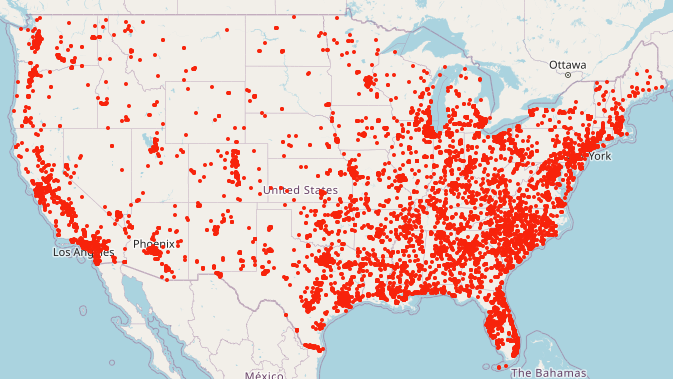
There have been more than 19,100 gun deaths, 39,100 gun injuries, and approximately 29,000 suicides in the United States in 2020. /Screenshot via Gun Violence Archive
There have been more than 19,100 gun deaths, 39,100 gun injuries, and approximately 29,000 suicides in the United States in 2020. /Screenshot via Gun Violence Archive
Editor's note: Maitreya Bhakal is an Indian commentator who writes about China, India, the U.S. and global issues. The article reflects the author's opinions, and not necessarily the views of CGTN.
Few things define America better than violence. The nation itself was founded on the most atrocious, unspeakable, and least discussed genocide of indigenous people in world history, and it has been on a constant killing spree since then. Whether it is the mass murders of millions of innocent civilians abroad (or the repeated election victories of leaders who commit such atrocities), or the killings of thousands of people at home – some Americans are fervently to kill - and elect people who do. It is perhaps no surprise that U.S. presidents have the highest approval ratings when they invade other nations.
Many outside America would obviously find such mass murder to be inhuman. Yet, it is profoundly American. It is an inalienable part of life in the Shining City on the Hill - as American as apple pie. Such homicidal behavior is the inevitable result of Americans coming to terms with the utter nihilism and depravity of American life and culture which encourages violence, a way of sublimating their frustration with Western capitalism and widespread poverty, and a coping mechanism for the constant climate of fear fostered by the regime.
Racial minorities in particular live in perpetual terror of the state apparatus, and a judicial system rigged against them. Crimes, both judicial and physical, against racial minorities are common, and are often tolerated - and frequently committed - by the state machinery.
An epidemic of violence
Into this deadly cocktail entered the deadliest pandemic in over a century.
Street violence was a normal part of life in America even before COVID-19. Many Americans have largely accepted their fate, having little choice against an unconcerned "elected" government that encourages such violence – let alone do anything to prevent it. Thus, it comes as no surprise that a mere epidemic – that has killed more than 562,000 Americans so far – would not decrease violence, even temporarily.
The U.S. response to COVID-19 increased poverty and unemployment – and also increased crimes. Many spent this time killing each other; multiple U.S. cities witnessed an unprecedented spike in murders.

A person reacts in the midst of a prayer during a vigil for Daunte Wright, who was shot and killed on Sunday by police during a traffic stop, in Brooklyn Center, Minnesota, April 12, 2021. /Getty
A person reacts in the midst of a prayer during a vigil for Daunte Wright, who was shot and killed on Sunday by police during a traffic stop, in Brooklyn Center, Minnesota, April 12, 2021. /Getty
According to Gun Violence Archive, over 19,000 people were killed in shootings and firearm-related incidents in 2020, the highest annual death toll in 20 years – not counting the additional 24,000 deaths by gun suicides. Mass shootings - classified as incidents in which four or more people are shot – rose in 2020 to their highest level in five years, and a nearly 50 percent increase from 2019.
What is most astonishing is the violence against children. School shootings are common in America. Yet, since most schools were closed last year, one would be forgiven for assuming that at least the children would be spared.
And one would be wrong. Nearly 300 children were shot and killed in 2020, a 50-percent increase from 2019. This happened despite many children attending class from home – and thus being saved from the normal school shootings.
The vaccine to gun violence
So what is the "elected" U.S. government doing to prevent such violence? The answer is: largely nothing. The U.S. regime has little incentive to stop such mass murder, and often encourages it. Keeping the proles at each other's throats serves its purpose well – people too busy to escape being shot would be less likely to demand better healthcare or infrastructure.
The U.S. Congress, which is seen by many as a corrupt body controlled by oligarchs that claims to "represent" the people, takes little action against gun violence - but will pass "defense" spending bills worth hundreds of billions of dollars with veto-proof majorities.
Internationally, U.S. bullying successfully prevents nations from holding it accountable for its human rights violations – beyond mere token statements. After all, if international bodies do so little to prevent (or even condemn) literal U.S. invasions of sovereign nations that kill millions – they are hardly about to start caring for U.S. atrocities committed against its own people.
Free speech vs. American values
To its credit, the American system does permit fairly open, public debate on the topic. The proles are allowed to let off steam by exercising their constitutional right to "free speech." Yet, in America, free speech largely serves as a substitute for action and change.
Take police violence for example. The much dreaded U.S. police frequently guns down people on the streets, killing about 1,000 civilians each year. When police kill a civilian, civilians protest vehemently. They write letters to their politicians and op-eds in newspapers, hold marches and rallies, demand police reform and stricter laws. Lawmakers listen to their concerns, express sympathy for the victims, and condemn the violence.
And the next day, the police kill another civilian.
(If you want to contribute and have specific expertise, please contact us at opinions@cgtn.com.)

